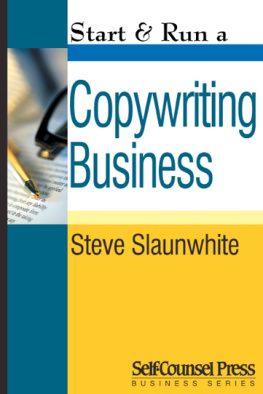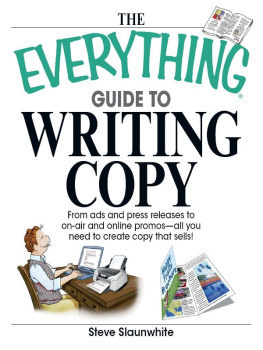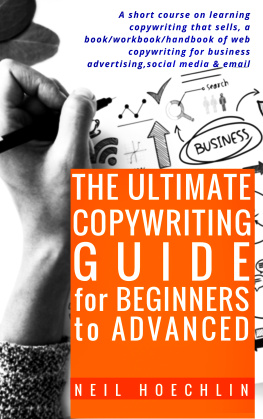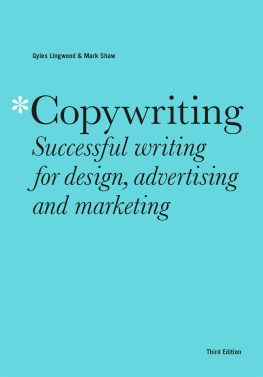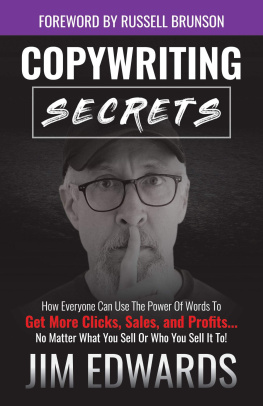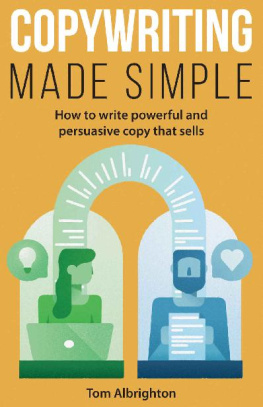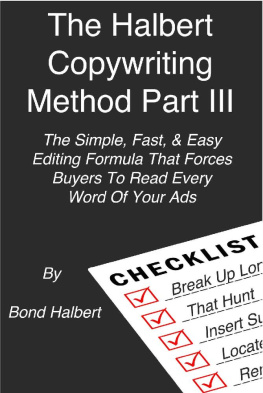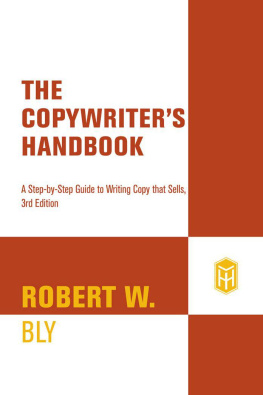Preface
When I wrote the first edition of this book in 2001, my goal was to create the most complete how-to guide available on the subject packed with information to help you learn the craft, set up your office, get clients, and make money.
Since that time a lot has changed. The growth of the Internet has revolutionized the business and created a wealth of new opportunities. In addition to the dozens of top-rated copywriters I originally interviewed for this book, Ive since spoken with more than one hundred some of the most highly paid in the world and learned their inside secrets to success.
Heres the good news: Youll find all this new information in this completely revised second edition. For example:
Updated details on setting up your copywriters office.
Expanded data on the markets available for your services, including insights into three of the most lucrative markets of all.
A completely revised and expanded chapter on how to get clients and get them fast.
Updates on how to complete typical copywriting tasks, with the addition of e-mail marketing, websites, microsites, e-zines, and blogs.
An expanded troubleshooting guide, based on the hundreds of letters and e-mails Ive received from readers over the years.
And much, much more.
So even if you have the original edition, I encourage you to upgrade. This new edition contains the latest information you need to succeed in this exciting business.
I wrote in the original preface to this book that many of us who are freelance copywriters lead a charmed life. (At least, we think so!) We spend our days happily ensconced in our comfortable home offices doing what we love to do which is to write.
Sure, there are ups and downs: client demands, challenging projects, deadlines. They come with the territory. But most copywriters I know love the creative, stimulating work; earn high fees; and enjoy an ever-increasing demand for their services.
Do you need writing experience? It helps. But, as youll read in the following pages, youll be amazed how many highly successful copywriters started with little or no background in writing, marketing, or even general business. In fact, one of the most highly paid copywriters I know was, just a few years ago, a kitchen renovation contractor!
So you may be a freelance magazine writer looking for a higher-paying market a consultant seeking a new revenue stream a marketing or advertising professional interested in going out on your own a stay-at-home mom or dad needing to earn some income on a flexible schedule a corporate employee dreaming of working from home in your jammies or even a freelance copywriter who wants to become even more successful
Whatever your reasons for picking up this new edition, Start & Run a Copywriting Business may be just the opportunity youre looking for.
Interested? Read on.
9
How to Complete Common Copywriting Tasks
Its impossible to list all the different types of projects youll encounter in your copywriting business. Just when I think I have tackled them all, a client challenges me with something new. For example, I recently completed a business-to-business telemarketing script for a team of professional sales representatives. Since these professionals approach sales scripts with varying degrees of resistance, this was a particularly challenging project.
So what kind of work can you expect to attract as a self-employed copywriter? Will you be writing the next great catchphrase for Coca-Cola? Creating new adventures for the Energizer Bunny? Scripting a tv commercial that plays for $2 million a minute on the next Super Bowl? Maybe. But I doubt it.
Glitzy consumer brands are usually handled by elite creative teams at large advertising agencies. Few freelance copywriters get assignments to write television commercials. (Ive written exactly one.)
This chapter contains the most common copywriting tasks youll receive from clients, and offers tips on how to best handle them.
Brochures and Other Sales Literature
There is nothing more ubiquitous in marketing communications than the brochure. It explains, educates, and sells; it is used as an aid during sales calls; it is used as a leave-behind after sales calls; it is mailed to fulfill sales inquiries; it is used as an enclosure in direct mail; it is handed out at trade shows; and it is included in press kits. Most buyers expect to find much, if not all, they need to know about a particular product or service in the brochure.
Brochures come in an astonishing array of sizes, shapes, and folds, from the basic slim Jim six-panel, to multipage, saddle-stitched tomes that approach book length.
Oddly, writing the brochure will not be your most difficult task as a copywriter. Your most difficult task will be organizing the information, and there are endless ways to do this. Which key messages should come first? What order should they be presented in? Which key messages should be grouped together?
When I write a product brochure, I like to start with a very short, succinct product description and then lead immediately into the most important and compelling benefit. Then I use headlines, subheads, callouts, and sidebars to break up and organize the copy in the most persuasive and captivating manner possible.
If Im writing a brochure to be used primarily as a sales aid, I imagine myself as a sales rep sitting across the desk from a potential client. I ask myself, Which benefits would I talk about first? What objections am I likely to face? How can I best overcome them? Then I organize the information in the same way as I would a sales presentation.
Heres an example of brochure copy that makes good use of benefits backed up by specifics to make a persuasive case:
An incredible 95 percent day-one release record
Fast. Thats the best word to describe how ABC Brokerage will steer your shipments through customs. Our leading-edge software systems and electronic link with us Customs combine to give us the earliest possible start on customs processing. The result is minimal delays at the border, meaning your shipments arrive where needed, sooner.
Sometimes brochures are designed to be more educational than sales oriented. For example, technical brochures are expected to provide clearly written product overviews and technical specifications. In these cases, I organize the brochure so the reader can easily glean what he or she needs to know. I include as much specific information as possible, and provide clear explanations and descriptions.
Heres an example of educational content from a financial services brochure. Note the headline written in the form of a question from the reader:
Okay, so just what is a Seg Fund?
Theres nothing mysterious about Seg Funds. Theyre simply investment funds held within an insurance contract. Theyre managed just like mutual funds. But because of the insurance contract, Seg Funds provide you with unique advantages and protection.
Perhaps the biggest mistake copywriters make when writing brochures is forgetting to include important information. Its surprisingly easy to forget the obvious. I once rewrote a brochure my client pulled from distribution because the original copywriter neglected to include one crucial product detail: the weight (an important point to consider before purchasing a roof-top industrial scrubber). Another brochure I recently received in the mail did not have any company contact information, not even a phone number. There was an empty spot on the back, presumably for distributor contact information, but this was missing. Who was I supposed to call if I was interested in this product?

